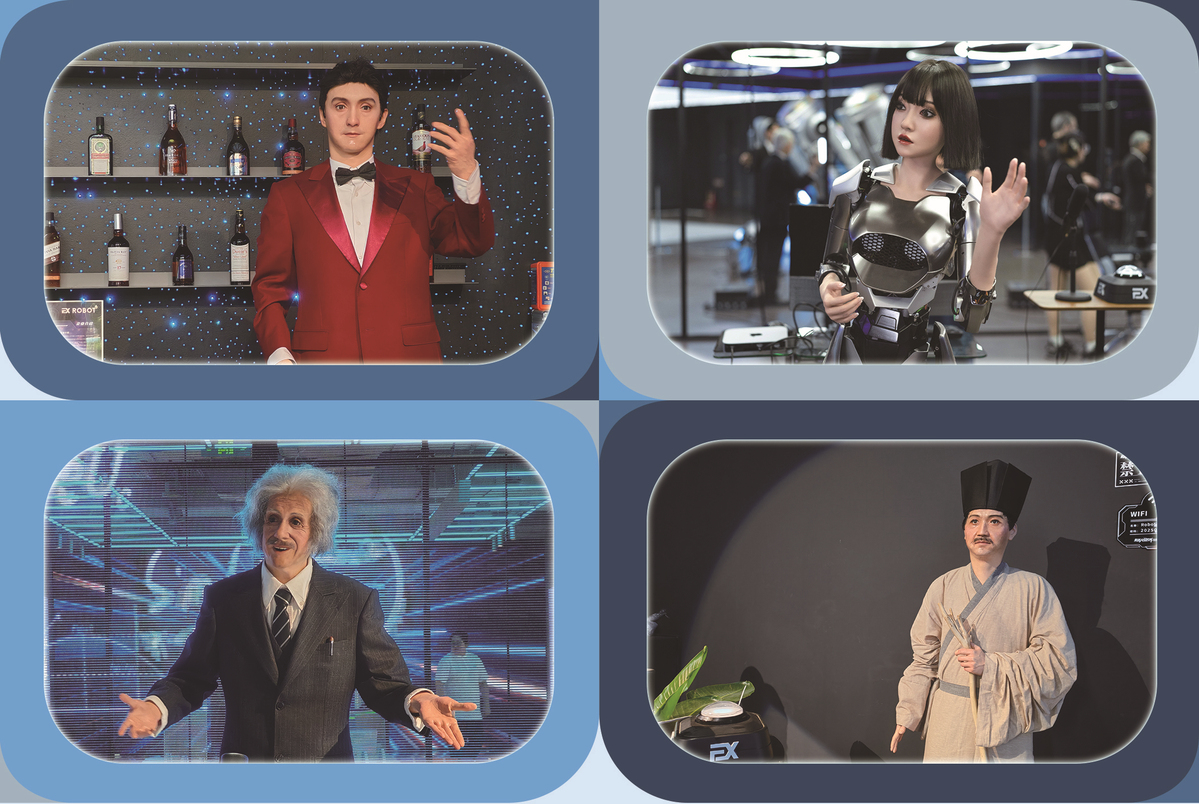When 'Li Bai' talks back
Beyond machinery, China's humanoid robots reveal emotion, intellect, and personality — redefining how people connect with artificial intelligence.


At Beijing's Robot Mall in Yizhuang — the world's first 4S store for humanoid smart robots — a figure named "Li Bai "takes center stage.
Dressed in traditional robes, this humanoid is modeled after the renowned Tang Dynasty (618-907) poet. Its lifelike features — from the delicately textured hair to the subtle wrinkles that move with speech — bring the ancient literary icon vividly to life.
The robot was developed by EX Robots, a tech company based in Dalian, Northeast China's Liaoning province.
"Our goal is to create machines that closely resemble humans, seamlessly integrating into daily life as true companions," said Li Boyang, co-founder and CEO of EX Robots.
Li's journey into robotics began in 2005, when he went to Japan to study smart algorithms at Waseda University. It was there that he first encountered humanoid robots. Seeing science fiction come to life inspired him to return to China in 2013 and build his own "cyber world".
While many companies prioritize bipedal movement, Li chose to concentrate on developing the upper body — the core of human expression and interaction.
"Most human abilities are in the upper body — gestures, facial expressions, and emotional cues — not just walking," he explained. That's why his research focuses on refining hand dexterity, sensory perception, facial micro-expressions, and emotional communication.
Unlike industrial robots with bulky mechanical arms, Li's designs are highly precise, allowing robots to mimic human hand movements and perform everyday tasks like typing or using scissors.
"Small desktop robots typically have only four or five movable joints, but our robots feature around 160 joints, each controlled by a sophisticated system," Li noted.
Because of the high cost and complexity, EX Robots has not yet made these creations available to individual consumers.
To bring these innovations closer to the public, Li's team established the EX Future Science and Technology Museum in several cities across China.
These spaces showcase the latest robots and include semi-open research centers where tech enthusiasts can experience cutting-edge technologies not yet on the market.
The robots are also displayed at major events. For example, at this year's Shanghai Cooperation Organization Tianjin Summit, "XiaoQi" — a robot developed by EX Robots — served as a guide, offering multilingual assistance to both local and international media.
With her short, stylish hair and sleek, futuristic mech suit, XiaoQi quickly became one of the standout figures of the company. "XiaoQi regularly appears at exhibitions," said Liu Shihua, 32, brand manager at EX Robots. "She continues to learn and adapt in complex environments, improving her ability to communicate naturally and seamlessly."
XiaoQi has also shown remarkable potential in elderly care. At an event last October focused on seniors, she not only demonstrated her ability to issue emergency alerts and remind elderly people to take their medication but also provided emotional companionship.
"XiaoQi has memory, which allows her to recall past conversations and interact with the elderly like a friend," explained Zheng Yaxin, 28, EX Robots' marketing head.
Liu recalled a moment at the 21st China (Shenzhen) International Cultural Industries Fair in May, when a visitor believed that the robot Li Bai was a real person.
"He spoke to the robot and even touched its skin, only to realize it was a machine," Liu said with a smile.
But EX Robots aims to give its creations more than lifelike appearances — they strive to give them a "soul".
Zheng remembers showcasing a robot named "Wang Shuhe", inspired by the Jin Dynasty (265-420) medical expert, at an exhibition. The robot's diagnostic skills drew a crowd eager for medical advice.
"Wang Shuhe doesn't respond in a stiff, mechanical way," Zheng said. "Instead, it offers medical explanations in a humorous and approachable manner."
"Just like humans, each of our robots has its own unique personality and thoughts," Li added.
This feature is now being integrated into EX Robots' smart classrooms, where figures like Albert Einstein and Isaac Newton "personally" share their knowledge with students.
The experience goes even further. When students interact with the robotic Su Shi, the renowned Song Dynasty (960-1279) poet, they don't just learn about his poetry but also the works of his scholarly peers, as well as the customs and political systems of his time.
"By engaging in direct dialogue with these 'real' historical figures, students gain a deeper, more dynamic understanding of the subjects they study," Li said.
Reimagining robot roles
As artificial intelligence continues to advance, more young people are entering the growing field of robotics. Yet Li has taken a calm, reflective approach.
"What makes robots truly valuable?" he asked. "Many people think robots should handle chores like cooking or doing laundry, but I don't see that as a real need."
He believes such tasks are better suited for specialized machines, while the true potential of humanoid robots lies in emotional communication and complex decision-making.
"Robots can become household assistants, interacting with smart devices and, more importantly, engaging in emotional exchanges," he said.
"The ideal relationship between humans and robots is one of collaboration, respect, and shared growth," Zheng added.

mengwenjie@i21st.cn
Today's Top News
- China commissions CNS Fujian in Hainan province
- Xi attends commissioning of China's Fujian aircraft carrier
- Xi congratulates Paul Biya on re-election as president of Cameroon
- Thai king to pay state visit to China
- Mars orbiter snaps images of interstellar object
- Gold VAT trade reform to bring healthier order






























